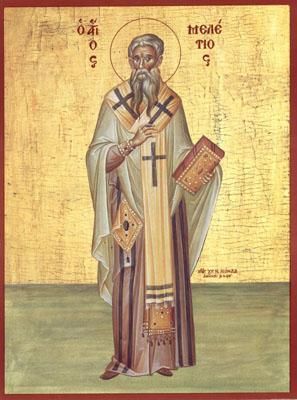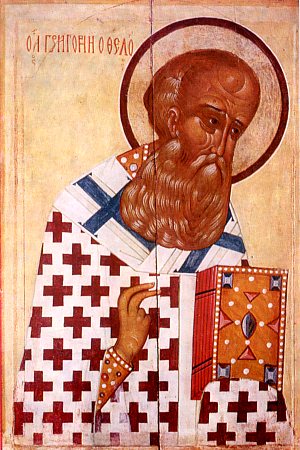
The First Council of Constantinople was a council of Christian bishops convened in Constantinople in AD 381 by the Roman Emperor Theodosius I. This second ecumenical council, an effort to attain consensus in the church through an assembly representing all of Christendom, except for the Western Church, confirmed the Nicene Creed, expanding the doctrine thereof to produce the Niceno-Constantinopolitan Creed, and dealt with sundry other matters. It met from May to July 381 in the Church of Hagia Irene and was affirmed as ecumenical in 451 at the Council of Chalcedon.

Gregory of Nazianzus, also known as Gregory the Theologian or Gregory Nazianzen, was a 4th-century archbishop of Constantinople and theologian. He is widely considered the most accomplished rhetorical stylist of the patristic age. As a classically trained orator and philosopher, he infused Hellenism into the early church, establishing the paradigm of Byzantine theologians and church officials.

Gregory of Nyssa, also known as Gregory Nyssen, was Bishop of Nyssa in Cappadocia from 372 to 376 and from 378 until his death in 394. He is venerated as a saint in Eastern Orthodoxy, Catholicism, Oriental Orthodoxy, Anglicanism, and Lutheranism. Gregory, his elder brother Basil of Caesarea, and their friend Gregory of Nazianzus are collectively known as the Cappadocian Fathers.

Eunomius, one of the leaders of the extreme or "anomoean" Arians, who are sometimes accordingly called Eunomians, was born at Dacora in Cappadocia or at Corniaspa in Pontus. early in the 4th century.

Cappadocia is a historical region in Central Anatolia, Turkey. It is largely in the provinces of Nevşehir, Kayseri, Aksaray, Kırşehir, Sivas and Niğde.

Basil of Caesarea, also called Saint Basil the Great, was Bishop of Caesarea Mazaca in Cappadocia, Asia Minor. He was an influential theologian who supported the Nicene Creed and opposed the heresies of the early Christian church, fighting against both Arianism and the followers of Apollinaris of Laodicea.

The Cappadocian Fathers, also traditionally known as the Three Cappadocians, were a trio of Byzantine Christian prelates, theologians and monks who helped shape both early Christianity and the monastic tradition. Basil the Great (330–379) was Bishop of Caesarea; Basil's younger brother Gregory of Nyssa was Bishop of Nyssa; and a close friend, Gregory of Nazianzus (329–389), became Patriarch of Constantinople. The Cappadocia region, in modern-day Turkey, was an early site of Christian activity.

Saint Meletius was a Christian bishop of Antioch from 360 until his death in 381. However, his episcopate was dominated by a schism, usually called the Meletian schism.
Peter of Sebaste was a bishop, taking his usual name from the city of his bishopric, Sebaste in Lesser Armenia. He was the younger brother of Basil of Caesarea, Gregory of Nyssa, the famous Christian jurist Naucratius, and Macrina the Younger. He is also known as Peter of Sebasteia.
Melitius or Meletius was bishop of Lycopolis in Egypt. He is known mainly as the founder and namesake of the Melitians, one of several schismatic sects in early church history which were concerned about the ease with which lapsed Christians reentered the Church.
In 4th-century Christianity, the Anomoeans, and known also as Heterousians, Aetians, or Eunomians, were a sect that held to a form of Arianism, that Jesus Christ was not of the same nature (consubstantial) as God the Father nor was of like nature (homoiousian), as maintained by the semi-Arians.
Eustathius of Sebaste was bishop of Sebastia in Armenia during the fourth century. He is known for his asceticism, his early opposition to slavery, and his friendship with Basil of Caesarea.
Domnica was a Roman empress as the wife of the emperor Valens, who ruled the East from 364 to 378. After the death of her husband at the Battle of Adrianople, she ruled as de facto regent and defended Constantinople against the attacking Goths until his successor Theodosius I arrived.

Nazianzus or Nazianzos, also known as Nandianulus, was a small town of ancient Cappadocia, and in the late Roman province of Cappadocia Tertia, located 24 Roman miles to the southeast of Archelais. In the Jerusalem Itinerary it is miswritten as Nathiangus.
Sasima was a town of ancient Cappadocia and in the late Roman province of Cappadocia Secunda, located 24 Roman miles to the south of Nazianzus.

Amphilochius of Iconium was a Christian bishop of the fourth century, son of a Cappadocian family of distinction, born, perhaps at Caesarea, ca. 339/340, died probably 394–403. He is venerated as a saint on November 22 in the Roman Catholic Church and on November 23 in the Orthodox Church.

Cappadocia was a province of the Roman Empire in Anatolia, with its capital at Caesarea. It was established in 17 AD by the Emperor Tiberius, following the death of Cappadocia's last king, Archelaus.
The Cappadocian Greeks, or simply Cappadocians, are an ethnic Greek community native to the geographical region of Cappadocia in central-eastern Anatolia; roughly the Nevşehir and Kayseri provinces and their surroundings in modern-day Turkey. There had been a continuous Greek presence in Cappadocia since antiquity, and the indigenous populations of Cappadocia, some of whose Indo-European languages may have been closely related to Greek became entirely Greek-speaking by at least the 5th century CE.
Doara was a town of ancient Cappadocia, inhabited in Byzantine times. It was in the Chamanene prefecture created by Archelaus of Cappadocia during Hellenistic times. The town appears on the Peutinger Table between Caesarea and Tavium. It was also mentioned by Hierocles as Rhegedoara (Ῥεγεδοάρα), and the Notitiae Episcopatuum.

Caesarea, also known historically as Mazaca, was an ancient city in what is now Kayseri, Turkey. In Hellenistic and Roman times, the city was an important stop for merchants headed to Europe on the ancient Silk Road. The city was the capital of Cappadocia, and Armenian and Cappadocian kings regularly fought over control of the strategic city. The city was renowned for its bishops of both the Greek Orthodox and Armenian Apostolic churches. After the Battle of Manzikert where the Byzantine Empire lost to the incoming Seljuk Empire, the city was later taken over by the Sultanate of Rum and became reconfigured over time with the influences of both Islamic and, later, Ottoman architecture.










